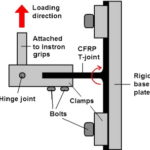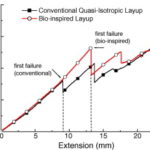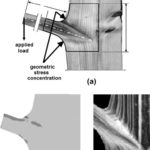Paper, Strength improvement to composite T-joints under bending through bio-inspired design
This paper shows that a bio-inspired design methodology is an effective method to strengthen composite T-joints under bending loading. The ply angles in the laminate of a carbon/epoxy T-joint were tailored using an optimization program mimicking the evolutionary process of adaptive growth in which the wood micro fibril orientation in and around the tree branch-trunk joint is tailored to the prevailing bending loading condition. A single objective optimization program with four ply angle input variables was used to compute the optimal design of the ply stacking pattern which minimized the inter laminar tensile stress in composite T-joints where de lamination damage is initiated. FEA and experimental testing were performed to compare the structural properties of the bio-inspired T-joint against a base-line T-joint with a quasi-isotropic ply stacking pattern. The bio-inspired T-joint exhibited a higher bending failure initiation load (improved by 40%) and elastic strain energy capacity (increased by 75%) than the base-line T-joint.
Learn about our two Decals!
 Click here to find out more about our Fall Bioinspired Design Decal and our Spring Bioinspired Design in Action Decal – ALL MAJORS are welcome.
Click here to find out more about our Fall Bioinspired Design Decal and our Spring Bioinspired Design in Action Decal – ALL MAJORS are welcome.Berkeley BioDesign Community
 Click here to learn about the BioD: Bio-Inspired Design @ Berkeley student organization or here to signup for more info.
Click here to learn about the BioD: Bio-Inspired Design @ Berkeley student organization or here to signup for more info.Search
Student Login






I imagine that the neurological circuits underlying these processes are governed by both 2d spacing maps with their brains as…
to reduce the impact of car accidents, it may be possible to study the force diverting physics of cockroaches to…
you see this type of head-bobbing stability in many avian creatures related to pigeons like chickens. the head ability to…
not like they taught horses how to run! this is an example of convergent evolution where both sea creatures and…
The brain functions in a similar way with neuronal connections. our brains are able to utilize the multiplicity of connections…